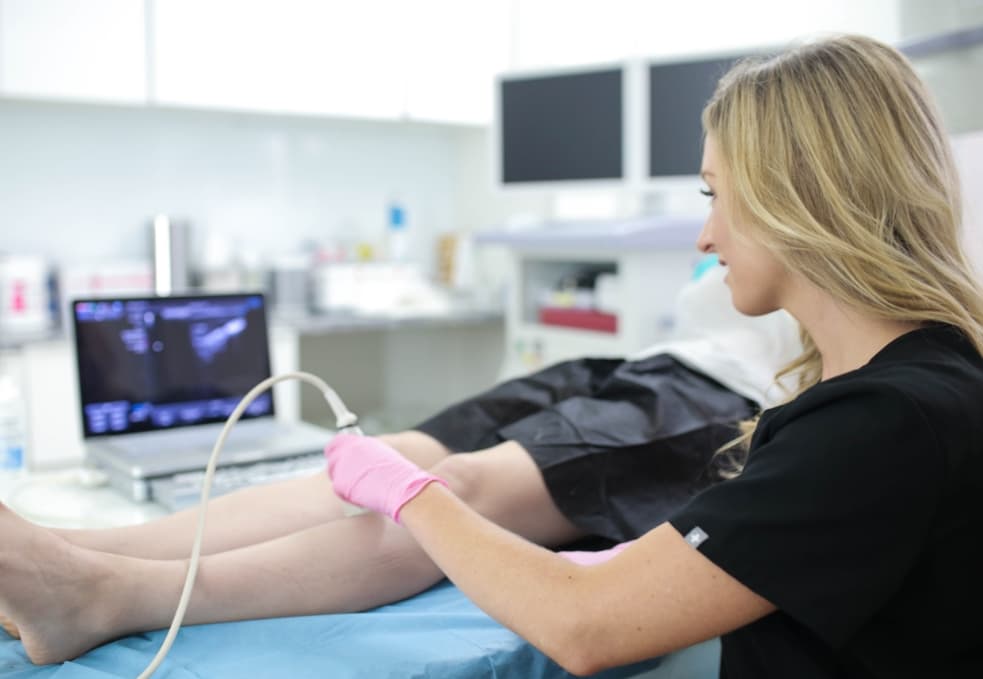Is vein mapping painful?
Vein mapping is a diagnostic procedure used to identify the damaged veins in a patient’s leg, which may lead to chronic venous insufficiency. During this procedure, a technician will map out any visible varicose veins to identify the condition’s extent and severity. While vein mapping sounds like it might be a painful experience, the reality is that it rarely causes any discomfort.
A patient may feel a cold sensation at most as the technician administers ultrasound waves after applying a cooling gel on the skin. Patients report virtually no pain during the vein mapping process. For some people, the sensation of something slightly tingling may be felt along the leg, but this is usually not uncomfortable enough to make a person stop the procedure.
Most vein mapping sessions take no longer than 15-20 minutes and do not require any numbing agents or special anesthetic. In other words, the process is painless and provides invaluable information that can determine what type of treatment is best for the patient. It can be a crucial first step toward getting the patient to recovery.
Long Island Vein Centers is a group of state-of-the-art vein centers specializing in minimally invasive spider vein and varicose vein treatments in Long Island. Our vein center is led by board-certified vein doctors who use cutting-edge technologies and techniques to diagnose and treat the root cause of your vein problems, not just the symptoms. You can find our vein doctors in West Islip, Jericho, Port Jefferson, or Hampton Bays.
Please schedule an appointment at your nearest vein center in Long Island.

How is vein mapping performed?
Vein mapping is a technique to look beneath the skin’s surface to identify and map the underlying veins to be used as potential sites for medical procedures. Vein mapping is often used to diagnose chronic venous insufficiency or perform minimally invasive treatments, such as radiofrequency ablation, laser ablation, and venaseal.
The vein mapping process begins with the patient’s arm or leg being shaved, cleaned, and rubbed with an antiseptic. The vein doctor then uses a low-frequency ultrasound (sonography) to identify and map the veins. This ultrasound uses high-frequency sound waves to detect the veins and create images of them in real-time. The images are then projected onto a computer screen so the doctor can identify and trace the routes of the underlying veins.
Overall, vein mapping is a safe and effective way to identify and map the locations of the underlying veins for medical procedures. The procedure is non-invasive, quick, and painless, providing precise and accurate results. This technique allows medical procedures to be performed quickly and with greater success.
What does vein mapping diagnose?
Vein mapping is a highly advanced diagnostic imaging technique that helps doctors accurately diagnose various medical conditions. It is the process of using sophisticated imaging technologies to create a detailed map of the veins in a patient’s body.
Vein mapping particularly helps diagnose and treat chronic venous insufficiency (CVI). CVI is a condition where the veins don’t carry the blood back to the heart effectively. It can cause pain, swelling, and ulcers in the legs and can significantly impact a person’s quality of life. Vein mapping can help doctors accurately diagnose CVI, providing detailed information about the veins and vessels.
What are the best minimally invasive treatment options for chronic venous insufficiency?
Chronic venous insufficiency (CVI) is a condition that affects the way your veins return blood to your heart. When healthy veins do their job correctly, they move blood one-way towards your heart in a circulation that helps to bring in oxygen and nutrients and carry away waste products. CVI occurs when the valves in the veins become damaged or weakened, which creates a pooling of blood in the leg veins, which can cause pain, swelling, and other symptoms.
Thankfully, minimally invasive treatment options are available for those suffering from CVI. These effective treatments can ease the pain and symptoms of CVI and improve circulation in the affected area. Some of the most popular minimally invasive treatment options include:
- Sclerotherapy: Sclerotherapy is a procedure in which a tiny needle injects a solution directly into the affected vein. This solution acts to irritate and damages the lining of the veins. This causes them to scar, shrink, and eventually disappear. Sclerotherapy can’t treat chronic venous insufficiency but can help with spider and varicose veins.
- Laser Ablation: This procedure uses a narrow beam of light energy to heat and destroy the affected veins. This results in the veins shrinking and eventually being absorbed by the body, and the accumulated blood reroutes into healthier leg veins.
- Radiofrequency Ablation: Radiofrequency ablation involves inserting a small catheter into the affected vein and delivering heat via radiofrequency energy. This causes the vein to collapse, resulting in accumulated blood reroutes into healthier leg veins.
- Compression Stockings: Compression stockings are special garments that pressure the legs and help reduce swelling. They also increase blood circulation and can be effective in treating CVI.
These minimally invasive treatments can reduce the symptoms of CVI, increase leg circulation, and improve quality of life. It is important to speak to your vein doctor to determine which minimally invasive treatment option would be most suitable for your condition. Also, you should follow all instructions from your doctor regarding the use of compression stockings and other forms of treatment for best results.

